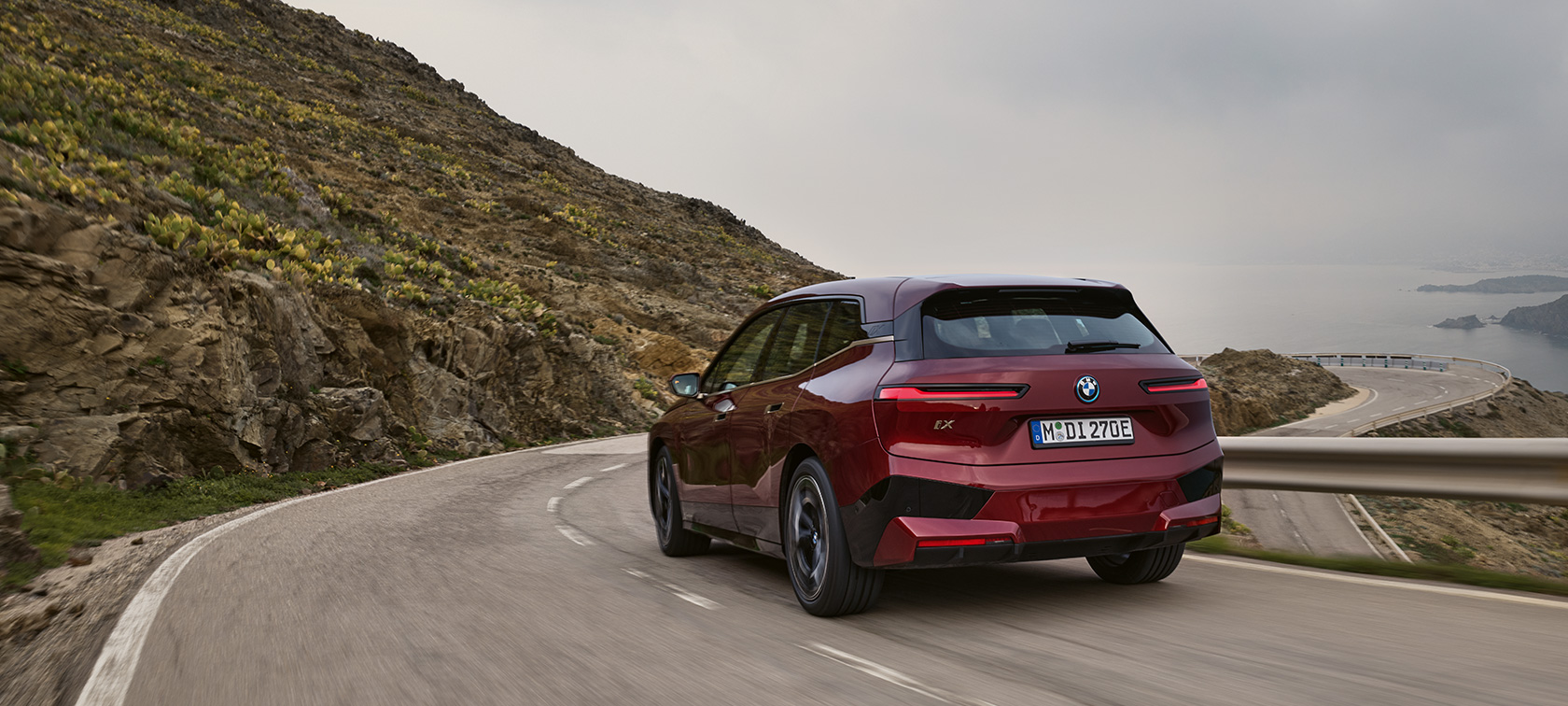Our tool for managing your permission to our use of cookies is temporarily offline. Therefore some functionality is missing.

THE iX
BMW iX: ENGINES & TECHNICAL DATA
ENGINES AND TECHNICAL DATA OF THE BMW iX.
- BMW iX xDrive40 Sport
- BMW iX xDrive50 Sport
-
No search result found. Please try another input

| Unladen weight in kg (EU) | 2,440 |
|---|---|
| Max. permissible weight in kg | 3,010 |
| Permitted load in kg | 645 |
| Permitted axle load front/rear in kg | 1,450/1,690 |
| Luggage capacity min. (seats up or roof down) in l | 500 |
| Luggage capacity max. (seats down or roof up) in l | 1,750 |
| Electric engine power kW (hp) at 1/min | 240 (326) |
|---|---|
| Electric Engine torque (Nm) at 1/min | 630 |
| Top speed fully electric in km/h | 200 |
|---|---|
| Acceleration 0–100 km/h in s | 6.1 |
| Electric range in km | Up to 425 |
|---|---|
| Capacity of lithium-ion battery in kWh | 76.6 |
| DC charging time in minutes, e.g. at DC fast charging station (charging power BMW iX xDrive40:150 kW; charging power BMW iX xDrive50: up to 200 kW; 10% - 80 %) | 34 min |
| AC charging time in hours, e.g. with Flexible Fast Charger / Wallbox (charging power 22 kW, 0% - 100%) | 3.45 h |
| Energy consumption in kWh/100 km (WLTP) | 22.5-19.3 |
|---|---|
| Fuel consumption combined in l/100 km | 0 |
| CO2 emissions combined in g/km | 0 |
| Tyre dimensions front | 275/40 R22 |
|---|---|
| Tyre dimensions rear | 275/40 R22 |
| Wheel dimensions and material front | 9.5 J × 22 inches, light-alloy |
| Wheel dimensions and material rear | 9.5 J × 22 inches, light-alloy |
| Unladen weight in kg (EU) | 2,585 |
|---|---|
| Max. permissible weight in kg | 3.145 |
| Permitted load in kg | 635 |
| Permitted axle load front/rear in kg | 1,530/1,780 |
| Luggage capacity min. (seats up or roof down) in l | 500 |
| Luggage capacity max. (seats down or roof up) in l | 1,750 |
| Electric engine power kW (hp) at 1/min | 385 (523) |
|---|---|
| Electric Engine torque (Nm) at 1/min | 765 |
| Top speed fully electric in km/h | 200 |
|---|---|
| Acceleration 0–100 km/h in s | 4.6 |
| Electric range in km | Up to 630 |
|---|---|
| Capacity of lithium-ion battery in kWh | 111.5 |
| DC charging time in minutes, e.g. at DC fast charging station (charging power BMW iX xDrive40:150 kW; charging power BMW iX xDrive50: up to 200 kW; 10% - 80 %) | 35 min |
| AC charging time in hours, e.g. with Flexible Fast Charger / Wallbox (charging power 22 kW, 0% - 100%) | 5.30 h |
| Energy consumption in kWh/100 km (WLTP) | 23.0-19.8 |
|---|---|
| Fuel consumption combined in l/100 km | 0 |
| CO2 emissions combined in g/km | 0 |
| Tyre dimensions front | 275/40 R22 |
|---|---|
| Tyre dimensions rear | 275/40 R22 |
| Wheel dimensions and material front | 9.5 J × 22 inches, light-alloy |
| Wheel dimensions and material rear | 9.5 J × 22 inches, light-alloy |
Energy consumption and CO2 emissions.
-
BMW iX xDrive40 Sport:
Energy consumption in kWh/100 km (combined): 122.5
Fuel consumption in l/100 km (combined): 0
CO2 emissions in g/km (combined): 0
BMW iX xDrive50 Sport:
Power consumption in kWh/100 km (combined): 35 min
Fuel consumption in l/100 km (combined): 0
CO2 emissions in g/km (combined): 0
The values of the vehicles labelled with (1) are preliminary.
The values of fuel consumptions, CO2 emissions and energy consumptions shown were determined according to the European Regulation (EC) 715/2007 in the version applicable at the time of type approval. The figures refer to a vehicle with basic configuration in Germany and the range shown considers optional equipment and the different size of wheels and tires available on the selected model.
The CO2 efficiency specifications are determined according to Directive 1999/94/EC and the European Regulation in its current version applicable. The values shown are based on the fuel consumption, CO2 values and energy consumptions according to the NEDC cycle for the classification.
For further information about the official fuel consumption and the specific CO2 emission of new passenger cars can be taken out of the „handbook of fuel consumption, the CO2 emission and power consumption of new passenger cars“, which is available at all selling points and at https://www.dat.de/angebote/verlagsprodukte/leitfaden-kraftstoffverbrauch.html.

